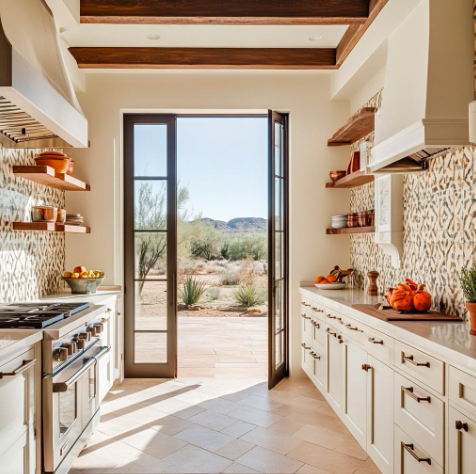
My apartment’s galley kitchen used to feel like a train corridor—long, narrow, and shadowy. Morning light slipped through a single window, bounced off dark oak doors, and disappeared before reaching the stove. Friends joked that cooking in there felt like “working in a suitcase.” I believed them. So when the time came for a small kitchen makeover, I skipped trendier colors and chose a quiet classic: cream kitchen cabinets. The switch added square footage where there was none, wrapped every corner in gentle warmth, and proved that the right neutral can outshine even the glossiest white.
Why Cream Works Wonders in Tight Kitchens
Reflects light without the glare.
True white cabinets blast light straight back at you, creating harsh contrasts—especially under task LEDs. A soft cream finish absorbs and diffuses brightness, removing stark shadows while still amplifying natural daylight. The result is a room that feels brighter and, crucially, calmer.
Adds warmth but never shrinks the room.
Dark stains swallow visual space; bright whites can look clinical. Cream sits comfortably between them. Its subtle yellow‑beige undertone radiates warmth, making compact kitchens feel welcoming rather than cramped, while its light value tricks the eye into reading more open area.
Pairs with nearly everything.
Renovating a small space on a budget means reusing what you can—existing floors, appliances, maybe even the backsplash. Cream’s chameleon quality harmonizes with warm butcher‑block counters, cool marble veining, stainless steel, or matte black fixtures. That flexibility saves money and decision fatigue.
Conceals everyday wear.
Grease splatters, dusty toe‑kicks, fingerprints—cream masks them longer than white, yet still cleans up easily with a damp microfiber cloth. In tight kitchens where every surface is within arm’s reach of the stovetop, low‑maintenance color matters.
From Color Choice to Complete Design
Pick the right shade.
Not all creams are equal. Cool‑leaning creams (with a touch of gray) keep spaces modern, while buttery tones lean traditional. Test swatches on foam board, move them around the room at different times of day, and watch how sunlight, under‑cabinet LEDs, and overhead bulbs shift the tone. My winner was a neutral cream with a whisper of gray—bright at noon, cozy at night, and never yellow.
Choose finishes that amplify brightness.
A satin sheen is Goldilocks for small kitchens. It reflects just enough light to widen the room without showing every brushstroke or roller line the way high‑gloss can. Factory‑finished doors, if within budget, provide the smoothest surface and resist yellowing longer than site‑painted MDF, but a high‑quality cabinet enamel brushed in thin coats can look nearly identical.
Coordinate counters and backsplash for visual flow.
In tight quarters, too many focal points compete for attention. Aim for understated elegance:
- Countertops: pale oak butcher block introduces organic warmth; light‑veined quartz echoes cream’s subtlety while adding a hint of luxury.
- Backsplash: glossy white or cream subway tile bounces light, while a matte glass mosaic in soft taupe introduces depth without distraction. Keep grout lines thin and color‑matched so the eye glides across the wall.
Select hardware that completes the mood.
Brushed brass pulls lean classic and enhance warmth; matte black handles add crisp, contemporary contrast. For an ultra‑streamlined look, integrated finger‑pull channels remove hardware entirely—perfect when every inch counts and visual clutter must stay low.
Light the layers.
Even the best color falls flat without strategic lighting. Swap bulky ceiling fluorescents for low‑profile LED panels that wash the room in even glow. Stick‑on under‑cabinet strips—$50 at most home‑improvement stores—erase dark corners on worktops. Finish with a small, clear‑glass pendant over the sink; its inner glow will dance across the cream doors each evening.
Practical Tips for Selection, Space‑Saving Layouts, and Care
Start with paint—or faux paint.
If new cabinetry isn’t in the budget, high‑adhesion cabinet enamel turns tired walnut doors into bright cream showpieces for less than $200 in materials. Clean thoroughly, scuff‑sand, apply a bonding primer, then two or three thin coats of enamel, sanding lightly between coats. Allow doors to cure flat for at least three days before rehanging to avoid tack marks.
Think vertically.
Cream cabinets naturally pull the eye upward, so extend uppers to the ceiling. The extra storage swallows seldom‑used appliances and keeps countertops free. Install slim pull‑down racks for spices and oils in the wall‑cabinet toe‑space; deep drawers with peg systems hold plates below counter height, eliminating overhead reach.
Use clever inserts to stretch every inch.
Toe‑kick drawers hide baking sheets; pull‑out pantry units only eight inches wide can store a week’s groceries. In my remodel, a 12‑inch cabinet next to the stove got a full‑height slide‑out for oils, vinegars, and cutting boards—a feature borrowed straight from luxury kitchens but DIY‑friendly with a ready‑made kit.
Maintain the glow.
Cream stays beautiful with minimal effort. Weekly, wipe doors with warm, soapy water and dry immediately. Every six months, tighten hinge screws and adjust soft‑close tension so doors stay aligned—crooked gaps are more noticeable on light surfaces. If a scuff appears, a magic‑eraser sponge usually erases it; deeper chips patch neatly with matching touch‑up paint from the original can.
A Brighter, Warmer Room—Without Moving Walls
Replacing dark cabinetry with cream kitchen cabinets turned my narrow space into the heart of the apartment—proof that you don’t need square footage to feel expansive. Friends who once teased the “hallway kitchen” now linger against the light‑oak counter, confident there’s room for all of us. More importantly, I cook more often. The brighter environment invites creativity; the warmth feels like a permanent morning sun.
If your own small kitchen feels cramped, try a paint swatch in soft cream. Hold it against the current cabinets. Imagine the walls breathing out instead of closing in. Color won’t add physical inches, but it will unlock every millimeter of light, calm, and comfort living in that room—and that’s space you can feel.
